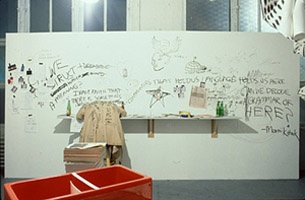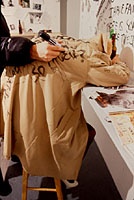Can You Work As Fast As You Like To Think?

 Gareth James, “New York City", 1998-1999
Gareth James, “New York City", 1998-1999
Here is one image of the studio at the end of the twentieth century. The scene is a boisterous opening at the short-lived MWMWM Gallery in Williamsburg. The room is filled with drifts of crumpled paper, unfinished drawings, stacks of art magazines, beer bottles and ashtrays — all the detritus of a workspace suspended between production and procrastination. Hand-scrawled broadsides line the walls. One reads “Art is like fire; it is born from what burns.” Off to the side, disguised in an old woman’s thrift store clothing, the British artist Gareth James sits hunched (asleep?) over a makeshift bar. He remains this way, head down, for the duration of the night. Guests enjoy themselves in art-boom sociality, waiting for something to happen, for the artist to wake up, to start talking, to orchestrate. He doesn’t. Whether out of sympathy with the evening’s excess of discursive openness or in defiance of it, some guests take up pens and begin inscribing comments, obscenities, and graffiti on the walls and artwork. A kind of self-conscious participation takes over. By the end of the opening even the artist’s passive body is a palimpsest of reception.
If one assumes that every representation of the studio also proposes a representation of art’s autonomy, the contingency of its relation to the wider world, the stakes of this image begin to announce themselves. In the present moment of post-dot.com retrenchment, where DIY artist collectives have returned to Sixties style counter-culture, the ability of art to imagine its autonomy has again become a pressing concern. [1] The politicized group consciousness that sought to radicalize questions of autonomy less than a decade ago — one thinks of Parasite in New York, A-Clip in Berlin, and BANK in London — now watches as graffiti crews and skateboard outsiders self-organize and prosper in an art market hungry for scalable rebellion. Images of autonomy are now battled over and sold by gallery dealers, lifestyle magazines and museums seeking to align themselves with youth culture. Freedom has revenged itself on an art world whose desire for alternatives swings wildly between earnestness and cynicism.
Entitled “New Work City” (1998-99), the installation described above is among the first of Gareth James’ many projects to attempt a retrieval of representations of artistic labor and autonomy from commercial interpolation. For its part, the work hypothesizes the space of art as a combustible form of subjectivity-negotiation. The historical representation of the studio as a place for art’s splendid isolation is literally overwritten by a haphazard, performed uncertainty as to what art might be. Another project, entitled wRECONSTRUCTION (2000), concerns autonomy in explicitly institutional terms. Rather than fill the American Fine Arts gallery with objects, images, or isolated experiences, James “invented” a freewheeling international curator, one Storm van Helsing, and had him “close” the gallery for the typical exhibition period of five weeks. During this time, the gallery’s doors remained locked except to those guests invited to participate in scheduled private conversations concerning what the gallery might do or be when open. Poached from the art world stratosphere, Van Helsing was a fiction meant to impinge on other fictions, especially those passing for reality: the gallery and museum as sites of art legitimation. His ostensible motto, printed on invitations and press releases, offered an earnest ethical koan to a superabundant art economy: “Just because you can, doesn’t mean you should.” [2] In an interview in Time Out New York van Helsing opined “Whether you’re a spiritualist engaging in some kind of mental tantric sex or a dialectitian, our freedom exists largely in the power to choose something other than that to which we’re fated […] What’s shocking is not that painting, sculpture, photography and video are the only kinds of exhibition now, but the degree to which they contribute to the suppression of other possibilities.” [3] Against art’s “fate” — an iMac or Chelsea version of cultural relations — these “other possibilities” are a matter of great ambiguity and urgency alike. Freedom? Self-sovereignty? It is rather the desire for these to be voiced reflexively, existentially, which James’ character yearns for.
James’ recent work proposes autonomy neither as individual production in remove (the modern artist’s atelier) nor as navigation of political consensus (post-studio collectivity). His “place of art” is rather more like a threshold between private and public, actuality and potentiality, the individual and the social. Or rather it is “the experience of the limit itself, the experience of being-within an outside.” [4] One thinks of Deleuze’s “politics of and” here: making art AND not making art AND disputation AND identification AND sociality AND the construction of subjective fiction. As a critical point, a place where meanings, properties and behaviors fluctuate radically, James’ provisional autonomy finds further elaboration in his many “paper sculptures,” the production of which has been a mainstay in his practice since his move to New York in 1997. From single sheets of white drafting paper, James has made miniature office dioramas, a two-headed 35mm camera, a life-size hospital gurney and a crutch. He has described these objects as “fast” abstractions: a way of “trying to speed up the way I work so that I might access all those forms of small value, too small to be worth spending half a year in production, that would have to be eradicated in order to present that unified and homogenous individual genius face to the art world.” [5] These works often have a kind of “pre-life” as drawings, the lines of which subsequently determine edges to be folded or glued together. Somewhat resembling architectural blueprints, these drawings function not just as schematizations of final built forms, but provide an initial representation of space as a hypothetical arbitration of reality. Seeing reproductions of the drawings next to their three-dimensional offspring, one appreciates the metaphors of movement and mediation that pervade James’ practice. The drawing accompanying his “Two-Headed Hollywood Camera” (1999) for instance, is a sprawl of rooms containing a DJ booth, a football stadium, a high-speed particle collider, a press office, and a swimming tank to be shared with dolphins and killer whales.
James’ work is both hyper-didactic and poetically distanced. It has a rapid and rhetorical abundance of manner. It can be intransigent, lyrical and declamatory by turns. It has something of YBA’s commonality and coarseness, but these are affectively translated through many layers of performed and assumed knowledge. The son of a Welsh policeman, James did his studies in the Slade’s media department in the early 1990s and then spent five years kicking around London’s artist-run spaces and East End storefront galleries (where he encountered, and would subsequently collaborate with, artists such as Dave Beech, Nils Norman and Merlin Carpenter). Following a historically conceptualist approach, James’ practice includes exhibition making as only one aspect of a much broader engagement with art and cultural production. Since his relocation to New York in 1997, he has curated, taught, and written extensively, all the while producing works for galleries and museums on a project or invitation basis.
Especially in the past two years, James has evolved into a unique form of artist-critic, contributing essays and polemics to Purple, Untitled, Texte zur Kunst, and Made in USA. This textual activity has evolved somewhat symbiotically from his work’s broader engagement with articulations of art autonomy. Like Dan Graham, Robert Smithson or Art & Language in the original moment of conceptual art, he has “used” the art magazine as a situating context for many of his art projects. James shares conceptualism’s recognition of the art magazine as a territorialization of discursive and symbolic exchange — a clearing house for representations of art, artists, critical position, consensus, bad faith and illusion — and, like Graham and Smithson before him, he has sought an exteriorized space within its glossy pages to test out negotiations of subjectivity. Works such as “Kill the Idiotz” (1998) and “Dazed & Confused” (1999) have involved a process of over-writing and insertion James has labeled “correction.” Made as limited editions, James’ corrected copies of Frieze and Dazed resemble mad confrontations between the official language of art representation and an embodied but changeable intelligence bent on exposing cultural distinction as ritualized con-game. Another work, “Ten-buck Phone Card” (1999, ongoing), similarly positioned the magazine as an allegory of symbolic value run amok. Staged as a performance the opening night of a group show at the American Fine Arts gallery in New York, the work’s monologue was “called-in” by James from a public phone booth in London. Following the totalizing logic of art’s expanded field, where “everyday life” is sited as legitimately and fantastically as anywhere else, the artist’s narrative hypothesized his urban surroundings as pages of a dematerialized magazine called “Firewall.” Promotional and critical forms were represented as billboards, local landmarks, and airplanes descending into Heathrow. Through the work’s delirious transpositions and projections, reminiscent of Situationist psycho-geography, art’s desire to escape or critique legitimating representation was simultaneously turned inward and scattered.
On one page of a magazine “corrected” by James, an advertisement for a particular brand of software reads “Can you work as fast as you like to think?” Such a question seems germane to James’ practice as a whole, given its reliance on figures of artistic labor, displacement and autonomy. What would it mean to work as fast as one thinks? Where would such work be situated, performed? What representations could encompass it? As the ability of art to incorporate all forms of cultural difference into ever-broader horizons of instrumental logic expands, James’ practice is a model of ambivalence and strategic negation. “I basically think that art should be almost impossible,” he writes. “Faced with all the end points of accomplishment, the studio is still that place where all the bad ideas haven’t been sorted out and discarded from the Darwinian fittest.” [6] This positioning of the studio is less a “return” than an actionable abstraction. One must rethink the studio not to reinscribe art’s isolation or separation from the world, but in order to posit a space of existential being with the world as grounds for any possible further elaboration of critique.
NOTES
| [1] | In a recent article surveying the “new” collectivity, Hollad Cotter lent his support to counter-cultural resurgence: “If contemporary art, marginal and minute as its influence is, doesn’t get it together and offer new models for a future some of us still hope to have, chances are at this point nobody will, and that’s more than a shame.” Holland Cotter, “Doing Their Own Thing, Making Art Together,” The New York Times, January 19, 2003, Section 2, 1, 36. |
| [2] | As in: just because you can fill a gallery with art each month doesn’t mean you should. |
| [3] | James’ construal of the Storm van Helsing persona is predicated on “Luther Blisset,” the umbrella pseudonym taken by a group of Italian anarchists faced with individual prosecution. Van Helsing, like Blisset, is a name contrived for strategic exigency and might be adopted by any individual wishing to participate in collective disavowal of official stricture. Indeed, the above quotes are “ventriloquized” through James and American Fine Arts gallery director Colin de Land alike, only two possible agents in the reimagining wRECONSTRUCTION proposed. See Tim Griffin, “Closed for Business,” Time Out New York, February 1, 2000. |
| [4] | Giorgio Agamben, The Coming Community (Minneapolis, Minnesota: University of Minnesota Press, 1993), 68. |
| [5] | Gareth James, in conversation with the author. |
| [6] | Gareth James, in conversation with the author. |
